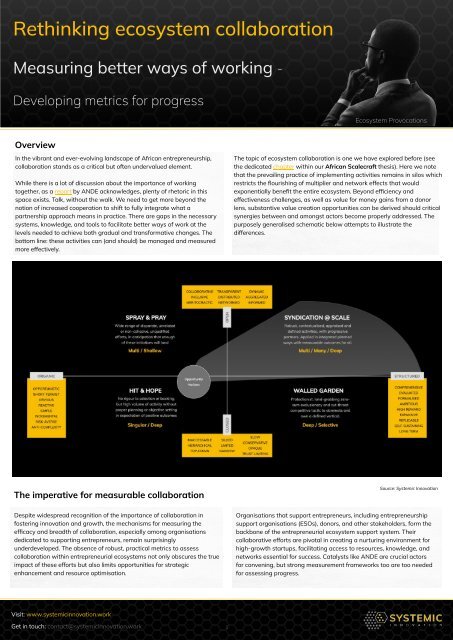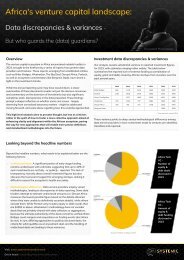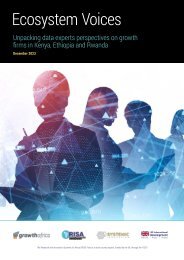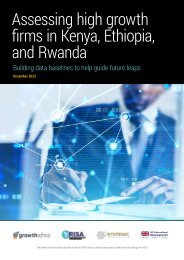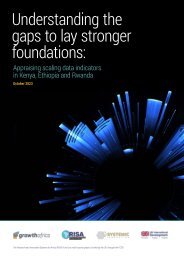Ecosystem Provocations - Rethinking Ecosystem Collaboration
Measuring better ways of working - developing metrics for progress
Measuring better ways of working - developing metrics for progress
You also want an ePaper? Increase the reach of your titles
YUMPU automatically turns print PDFs into web optimized ePapers that Google loves.
<strong>Rethinking</strong> ecosystem collaboration<br />
Measuring better ways of working -<br />
Developing metrics for progress<br />
<strong>Ecosystem</strong> <strong>Provocations</strong><br />
Overview<br />
In the vibrant and ever-evolving landscape of African entrepreneurship,<br />
collaboration stands as a critical but often undervalued element.<br />
While there is a lot of discussion about the importance of working<br />
together, as a report by ANDE acknowledges, plenty of rhetoric in this<br />
space exists. Talk, without the walk. We need to get more beyond the<br />
notion of increased cooperation to shift to fully integrate what a<br />
partnership approach means in practice. There are gaps in the necessary<br />
systems, knowledge, and tools to facilitate better ways of work at the<br />
levels needed to achieve both gradual and transformative changes. The<br />
bottom line: these activities can (and should) be managed and measured<br />
more effectively.<br />
The topic of ecosystem collaboration is one we have explored before (see<br />
the dedicated chapter within our African Scalecraft thesis). Here we note<br />
that the prevailing practice of implementing activities remains in silos which<br />
restricts the flourishing of multiplier and network effects that would<br />
exponentially benefit the entire ecosystem. Beyond efficiency and<br />
effectiveness challenges, as well as value for money gains from a donor<br />
lens, substantive value creation opportunities can be derived should critical<br />
synergies between and amongst actors become properly addressed. The<br />
purposely generalised schematic below attempts to illustrate the<br />
differences.<br />
The imperative for measurable collaboration<br />
Source: Systemic Innovation<br />
Despite widespread recognition of the importance of collaboration in<br />
fostering innovation and growth, the mechanisms for measuring the<br />
efficacy and breadth of collaboration, especially among organisations<br />
dedicated to supporting entrepreneurs, remain surprisingly<br />
underdeveloped. The absence of robust, practical metrics to assess<br />
collaboration within entrepreneurial ecosystems not only obscures the true<br />
impact of these efforts but also limits opportunities for strategic<br />
enhancement and resource optimisation.<br />
Organisations that support entrepreneurs, including entrepreneurship<br />
support organisations (ESOs), donors, and other stakeholders, form the<br />
backbone of the entrepreneurial ecosystem support system. Their<br />
collaborative efforts are pivotal in creating a nurturing environment for<br />
high-growth startups, facilitating access to resources, knowledge, and<br />
networks essential for success. Catalysts like ANDE are crucial actors<br />
for convening, but strong measurement frameworks too are too needed<br />
for assessing progress.<br />
Visit: www.systemicinnovation.work<br />
Get in touch: contact@systemicinnovation.work<br />
1
Crafting metrics for collaboration<br />
The development of metrics to assess ecosystem collaboration calls for a<br />
comprehensive approach that encompasses both quantitative and<br />
qualitative dimensions. Quantitatively, metrics such as the number of<br />
collaborative initiatives, network connectivity, stakeholder participation<br />
(and network analysis) , and cross-organisation memberships can provide<br />
simple but valuable insights into the scope and scale of collaborative<br />
efforts. These indicators reflect not only the volume of collaborative<br />
activities but also the depth (and breath) of engagement and<br />
interconnectedness within the ecosystem.<br />
Qualitatively, assessing the outcomes of collaboration, stakeholder<br />
satisfaction, innovation generated (co-developed), and the inclusivity of the<br />
ecosystem offers a deeper understanding of the value and effectiveness of<br />
these partnerships. Metrics focusing on (co-)investment success, feedback<br />
from ecosystem participants, and the diversity and inclusivity of the<br />
ecosystem can capture the more nuanced impacts of collaboration to<br />
ensure a more supportive environment.<br />
Multiplier outcome gains await<br />
<strong>Ecosystem</strong> collaboration expert, Ed Morrison (see Strategic Doing) points<br />
to different types of networks that combine to form an ecosystem:<br />
advocacy, learning, and innovating networks. He describes “Innovating<br />
Networks”, which have a particular structure: tight core teams and porous<br />
boundaries - these are the main value generators of an ecosystem.<br />
<strong>Collaboration</strong> between actors is a process of recombinant innovation<br />
among partners who have developed a spirit of mutuality (which is<br />
predicated on moves away from from ‘turf’ towards ‘trust’). These actions<br />
can generate new value by experimenting with recombining the assets<br />
embedded in their networks.<br />
The (projected) multiplier outcomes associated with change (and some of<br />
the associated tools) are indicated in the graphic below. At the top of the<br />
pyramid are the multiplier benefits derived from synthesis of activities<br />
(which is a step beyond collaboration, which itself can too frequently be<br />
thin, loose, transactional, time-bound, and conditional). The ultimate aim is<br />
towards synthesis and interdependence to drive systems gains.<br />
Beyond metrics: envisioning collaborative futures<br />
Levels of Systemic Synergy Source: Dark Matter Labs<br />
The quest for actionable, relevant metrics to gauge collaboration within<br />
entrepreneurial ecosystems transcends the mere quantification of<br />
activities. It is about nurturing meaningful partnerships that drive not only<br />
innovation and economic growth but also inclusivity and sustainability.<br />
Clear, simple benchmarks for collaboration can illuminate the path<br />
forward, guiding strategic improvements and fostering a more<br />
interconnected, effective entrepreneurial landscape. Coordinating an<br />
ecosystem is a challenging endeavour. It demands an understanding of the<br />
various motivations and needs of stakeholders, the ability to foster<br />
relationships, and the skill to facilitate impactful discussions that propel the<br />
network forward.<br />
This also involves securing the commitment of various participants in the<br />
ecosystem. The task of aligning numerous interventions within the<br />
ecosystem to pursue joint or supportive objectives is both lengthy and<br />
complicated. The discourse on developing collaboration metrics is<br />
important but also it challenges us to rethink the foundations of<br />
entrepreneurial support. As ecosystems evolve, so too must our<br />
approaches to measuring and enhancing the collaborative ties that bind<br />
them. By embracing a more nuanced, comprehensive framework for<br />
assessing collaboration, we can unlock new avenues for growth,<br />
innovation, and inclusivity, ensuring a thriving future for entrepreneurs<br />
worldwide.<br />
Acknowledgments: We extend our heartfelt thanks to our systemic colleagues and<br />
ecosystem partners who generously offered their insights and comments on a draft<br />
version. Any mistakes or oversights within this article are solely the responsibility of<br />
the author.<br />
Visit: www.systemicinnovation.work<br />
Get in touch: contact@systemicinnovation.work<br />
2<br />
We are a systems change innovation practice.<br />
Solving wicked systemic challenges through a collective<br />
intelligence model that connects people, ideas and insights.


